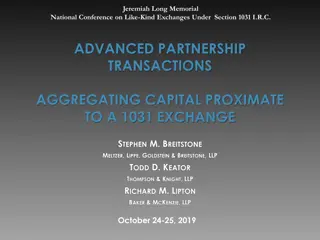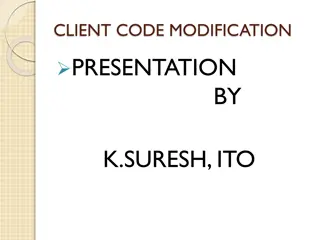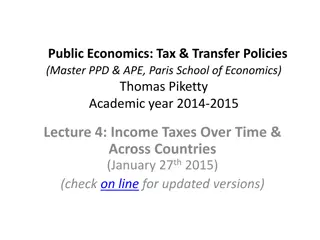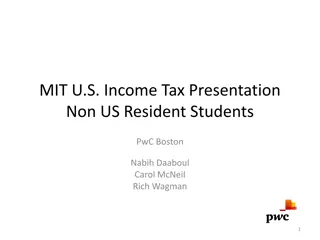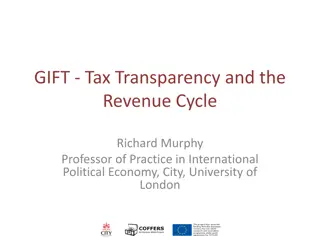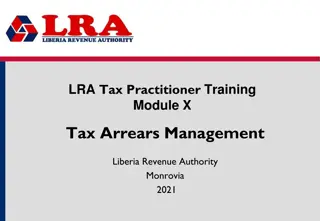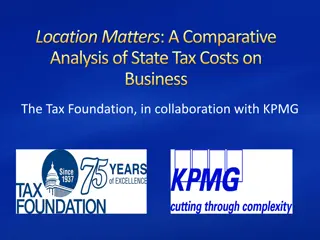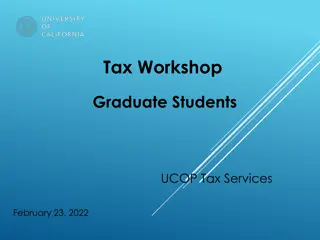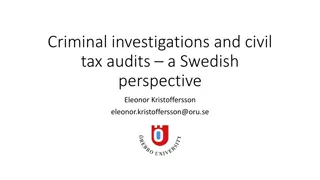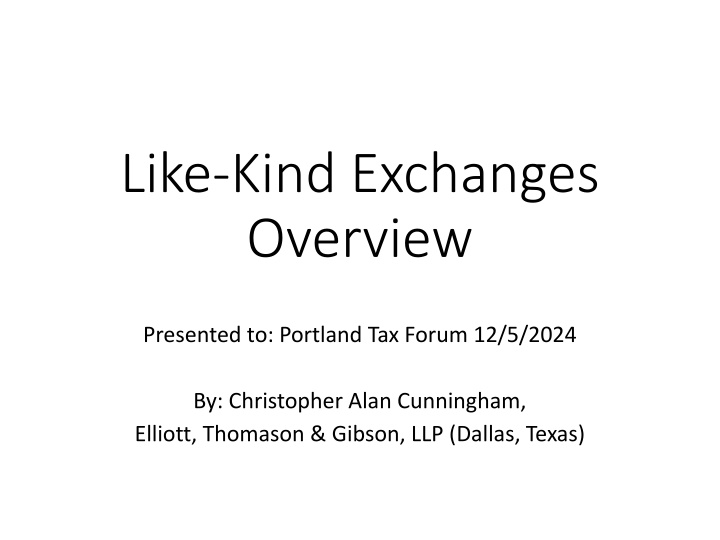
Like-Kind Exchanges for Tax Advantages
Learn about like-kind exchanges and how they offer tax benefits when exchanging similar properties without triggering immediate taxes. Discover the requirements, tax implications, and examples of direct and deferred exchanges.
Download Presentation

Please find below an Image/Link to download the presentation.
The content on the website is provided AS IS for your information and personal use only. It may not be sold, licensed, or shared on other websites without obtaining consent from the author. If you encounter any issues during the download, it is possible that the publisher has removed the file from their server.
You are allowed to download the files provided on this website for personal or commercial use, subject to the condition that they are used lawfully. All files are the property of their respective owners.
The content on the website is provided AS IS for your information and personal use only. It may not be sold, licensed, or shared on other websites without obtaining consent from the author.
E N D
Presentation Transcript
Like-Kind Exchanges Overview Presented to: Portland Tax Forum 12/5/2024 By: Christopher Alan Cunningham, Elliott, Thomason & Gibson, LLP (Dallas, Texas)
Concept Exchanging property for similar property is a continued investment, which should not be taxed. Converting to other types of property or having access to proceeds should be taxed. Section 1031 of the Internal Revenue Code ( IRC ). Exchange implies mutual transfer of property. Where not mutual, use deferred and reverse exchange structures discussed below. Swap till you drop eliminate prior deferred gain through estate step-up in basis 1
Requirements Exchange of relinquished property for replacement property Same Taxpayer must dispose of relinquished property and acquire replacement property. Both relinquished and replacement must be: Real property (as of 1/1/2018) like kind held for productive use in a trade or business or for investment (the held for requirement) Not: personal use or inventory/dealer property/ held for sale Special requirements for exchanges with related parties. 2
Tax, Boot, Basis, and Deferral Tax on gain both realized and recognized Gain realized = sales price or fair market value basis Gain recognized= lesser of boot or gain realized. Boot recognizes gain dollar for dollar without basis offset! Boot Cash Non-like-kind property Debt boot - deemed boot to the extent debt encumbering replacement property is less than debt encumbering relinquished property. Offset for outside cash Basis in replacement property = relinquished property basis + gain recognized value of boot + additional cash/etc. Low basis means gain is deferred instead of eliminated. 3
Direct Exchange Example Deed Exchangor A Exchangor B Deed $10 Cash Property A Property B Value: $100 Basis: $25 Realized gain: $75 Value: $110 Basis: $60 Realized gain: $50 No recognized gain Basis received: $35 ($25 + $10) Recognizes $10 gain Basis received: $60 ($60 + $10 - $10) 4
Deferred Exchanges Contract Buyer Exchangor Treas. Reg. 1.1031(k)-1. Exchangor engages a qualified intermediary ( QI ) Exchangor assigns contract to QI, which receives the proceeds. QI holds proceeds in QI account Exchangor assigns purchase contract to QI, which disburses funds held. Timeline: Exchangor has: 45 days to identify candidate replacement property in writing, and 180 days to complete exchange. Unspent QI funds becomes boot. QI cannot allow Exchangor to have benefit of (use, borrow against, etc.) funds held by QI during the exchange. (called the (g)(6) restrictions ). Deed Assign Contract QI Contract Seller Exchangor Deed Assign Contract QI 5
1031 Cooperation Clause Lightweight example: Buyer is aware that Seller intends to perform an IRC Section 1031 tax deferred exchange. Seller requests Buyer s cooperation in such an exchange and agrees to hold buyer harmless from any and all claims, costs, liabilities, or delays in time resulting from such an exchange. Buyer agrees to an assignment of this contract by the Seller. Longer example: If Seller elects to enter into a 1031 exchange as part of this transaction, Buyer will cooperate with Seller in the exchange, provided, however, that Buyer shall not be obligated to pay any fees, costs, or expenses in connection therewith. If Seller elects to pursue a 1031 exchange, Seller agrees (i) to pay all fees and closing costs associated with the exchange of property contemplated hereunder, including but not limited to fees payable to the intermediary and the cost of title insurance for the exchange property, and (ii) to reimburse Buyer for any actual out-of-pocket costs incurred by Buyer at the request of the Seller in support of the 1031 exchange. These are Seller versions. For Buyer versions, swap Seller and Buyer. 6
Related Party Exchanges IRC 1031(f) exchanges between related parties Related standard is in IRC 267(c) and 707(b) Family: siblings, spouse, ancestors, & descendants not aunts, uncles, or cousins Generally for entities: >50% common ownership Beware ownership attribution rules (including reattribution) Disposition within 2 years triggers gain for both related parties. Exclude: death, compulsory/involuntary conversion (if exchange before threat or imminence) Substantial diminution of risk (i.e. puts/calls/short sales) stops the 2-year clock. Strictly speaking, 1031(f) doesn t apply to QIs and deferred exchanges. BUT 1031(f)(4) anti-abuse rule is applied consistently. any exchange which is part of a transaction (or series of transactions) structured to avoid the purposes of this subsection [1031(f) on related party exchanges] Essentially, related parties must chain exchanges together to have cash/gain recognition land with an unrelated 3rd party. 7
What is Real Property Before 2017 Tax Cuts and Jobs Act, could also exchange like-kind personal property Treas. Reg. 1.1031(a)-3 follows prior law of like-kind Land, undivided interests in land, natural products of land (unsevered), mineral interests Improvements to land structural components of inherently permanent structures Certain real property intangibles leases, easements, option to acquire real proerty, licenses to use real property, etc. Ultimately falls back to state law 8
What is Like Kind Real Property Precise use is irrelevant(so long as meet the held for requirement) Contrast with IRC 1033 involuntary conversion like-use standard Rental single family home for factory is OK Farm for office building is OK Generally, real property was defined following like-kind except Long term (>30 year term) lease must be bona-fide lease for tax purposes Watch for finance leases (in substance a loan) Short-term leases MIGHT be like-kind to each other Permanent easements Is a non-permanent easement a license to use real property ? 9
Tenants-in-Common Rev. Proc. 2002-22. Key issue: TICs cannot be deemed partners in a partnership. Must receive rent not participate in active business. Must be tenants-in-common ( TIC ) under state law. Maximum 35 persons. Must be heads-up deal (strictly % based, same % in all parcels). Debt must be pro-rata too. May (should): TICs execute an agreement ( TIC Agreement ) where TICs agree to meet requirements listed in Section 5 of Rev. Proc. 2002-22. employ agent ( Property Manager ) under a property asset management agreement ( PAMA ) to manage the property. 10
Tenants-in-Common TICs execute TIC Agreement. TICs and Property Manager execute PAMA. Property Manager handles leasing to avoid TIC collective action problem. Property Manager collects rent, pays expenses, and distributes relative shares of net income to TICs. A B TIC Agreement Distributions Real Property Property Manager Leases Leases Leases Tenants 11
Delaware Statutory Trust (DST DST ) Rev. Rul. 2004-86 and Delaware Statutory Trust Act (12 Del.C. 3801 et seq) Logic: DST is a multi-beneficiary grantor investment trust, so beneficial interest ( BI ) holders treated as owning undivided interest in trust assets. investment trust under Treas. Reg. 301.7701-4(c) must: Single class of beneficiaries, Not have power to vary the investment of the trust, and Be limited to conserve and protect trust property. Contrast with business trust which is treated as business entity under check- the-box regulations. Treas. Reg. 301.7701-4(b). grantor trust means tax pass-through. Grantor qualification under Subchapter J (IRC 667 et seq) Contrast with complex trust which is a separate regarded taxpayer. Like TICs, must not be deemed a partnership. Verystrict cash management rules to avoid varying the investment 12
7 Deadly Sins of DSTs The trustee cannot disposeof the trust s property and then acquire newproperty (although the trustee can sell the trust s assets and dissolve the trust). The trustee cannot enter into new leases.1 The trustee cannot renegotiate a lease with an existing tenant.1 The trustee cannot enter new debt encumbering the trust s assets. The trustee cannot renegotiate any existing debt. The trustee cannot invest cash received to profit from market fluctuations (all cash must be investment in short-term Treasuries that will be distributed at the end of each calendar quarter). The trustee may not make more than minor, non-structural modifications to the trust s property not required by law. 1. except in the case of [tenant s]bankruptcy or insolvency 13
DST Example BI Holders Creator (often an affiliate of the DST syndicator called the depositor ) owns real property. DST Formation Steps: Creator leases to tenant(s), Creator contributes to DST in exchange for all of the beneficial interests; Creator sells beneficial interests to exchangors (typically); DST collects rent from tenant and distributes it to the beneficial interest holders. Distributions DST Real Property Lease(s) Rent Tenant(s) 14
Solving DST/TIC Problems the MTE BI Holders DST owns real property but leases ( Master Lease ) to master tenant entity ( MTE ). MTE ownership needs some difference from DST ownership to support master lease for tax purposes. MTE sub-leases to Tenants. It can do the 7 deadly sins for itself. MTE rent to DST is independent of its rent received from Tenants. MTE has economic risk (and ideally, relevant profit margin). (This also works in TIC deals to solve trade/business issues.) Distributions DST Real Property Master Lease Rent Leases Leases Leases MTE Tenants Rent 15
Reverse & Improvement Exchanges What if you want to: Buy before you sell? Build something? Safe Harbor reverse exchanges defined by Rev. Proc. 2000-37 Exchange Accommodation Titleholder ( EAT ) acquires qualified indicia of ownership of replacement property. Exchangor contracts to acquire and assigns that contract to the EAT. Exchangor may fund EAT s acquisition and may lease from EAT. (Rev. Proc. 2000-37 is permissive on non-market terms) 45 days to identify & 180 days to close from date EAT obtains qualified indicia (otherwise just like in a deferred exchange). Typically use QI in a deferred exchange to sell relinquished property and acquire replacement property from EAT. Exchangor Non-safe-harbor parking arrangements exist, although present additional tax risk. Typically structured similarly, but longer than 180 days to close. Estate of Bartell v Commissioner, 147 T.C. No. 5 (2016): 2 years to close. 16
Reverse Exchange Example Process 1. Exchangor engages EAT and assigns the contract to buy replacement property. EAT forms LLC as a disregarded entity. Engagement includes contract to purchase LLC from EAT. 2. LLC acquires replacement property (and performs any construction). Piggy bank issue where does LLC get the money to buy? Loan from Exchangor or an affiliate of Exchangor? From a 3rd Party? 3. Exchangor sells relinquished property through QI as normal. 4. Exchangor assigns contract to buy LLC from EAT to QI. 5. Exchangor acquires LLC (with the replacement property) from EAT, using QI account to fund purchase. Includes assumption of any unpaid debts of LLC. This is how replacement debt is created. 6. EAT uses proceeds of sale to pay back loan(s) 17
The Same Taxpayer Problem The same taxpayer must dispose of relinquished and acquire the replacement property. IRC 1301 places specific emphasis on the identity of the exchanging taxpayer. Disregarded entities are disregarded, so can acquire in them/sell through them. Partnerships: what if some partners want to exchange but others want cash Solution 1: Drop-and-swap (if early in process, particularly before marketing or contracting to sell) Solution 2: PIN Transaction (if too late for drop-and-swap) Fact pattern for examples: A, B, and C are members in LLC (tax partnership) that wants to sell real property. A and C want to exchange. B wants to cash out. 18
Traditional Drop-and-Swap A B C 1. LLC liquidates, distributing tenant-in-common interests in assets to A, B, and C. Need a TIC Agreement and Property Manager/PAMA (not shown) 2. A, B, and C (NOT LLC) contract and sell to Buyer. 3. A, B, and C each separately: Decide whether or not to exchange, and Perform their own exchanges A and C only must replace their shares of debt. TIC Deed LLC RQ A B C QI Buyer RQ A&C s Share (to QI Accounts) 19
Synthetic Drop-and-Swap Instead of LLC distributing TIC interest, LLC contributes the property to a DST, then distributes BIs in DST to A, B, and C. DST sells to Buyer, assigning right to receive proceeds to A, B, and C (which A and C can assign to the QI to start their respective exchanges). B does nothing and receives cash. Why? Lenders often hate TICs but are OK with DSTs (Fannie lenders recently showing preference for small TICs over DSTs). DST is a single negotiator for the sale. In a TIC arrangement, all TICs must participate in the sale. Dissident TICs can kill the sale. BI holders don t have any say in a DST, so cannot kill the sale. Not as messy (particularly on title record) as TIC arrangement. 20
Drop-and-Swap Timing Held For challenges are dead. Magneson, 753 F.2d 1490 (9th Cir. 1985); Bolker, 81 T.C. 782 (1983); Maloney, 93 T.C. 89 (1989). The current test is who is the seller with economic substance. Court Holding Co., 324 U.S. 331 (1945) mere conduit through which to pass title vs. Cumberland Pub. Serv. Co., 338 U.S. 451 (1950) sale by the stockholders rather than the corporation Synthetic Drop-and-Swap has reduced risk in late transaction: Dover Corp., 122 T.C. No. 19 (2004): check-the-box liquidation of CFC subsidiary immediately before CFC s sale of subsidiary stock respected California & New York aggressively argues that transactions are subject to Court Holding. Summary: Before marketing is best After contract is binding (no contingencies) is risky. Immediately before closing is potentially unsupportable. 21
PIN Transaction PIN: partnership installment note LLC is the exchangor, and engages QI for a deferred exchange almost as normal. QI receives exchanging share(s) of proceeds into the QI account. QI also receives remaining share(s) but into its own operating account. It issues notes at closing for that share of cash. Remainder is received into the exchange account as normal. Notes pay >5% principal in following tax year to qualify for installment method Notes are then used to redeem cash out partners. Partnership continues exchange as normal, but without cash out partners. Since partnership is exchangor, solves the held for problem of a drop-and-swap. Partnership must spend A and C s shares of cash (QI account), but must replace all debt to avoid debt boot. A B C Redeem for Note Buyer LLC Deed Assign Note QI 22
Partnership Division Similar to Traditional Drop-and-Swap, but instead of distributing TIC interests to the partners Partnership divides into separate partnerships holding TIC interests. Each resulting partnership is a continuation under Treas. Reg. 1.708-1(d) Requires >50% continuing partners in each divided partnership. Example: Division #1: 99% A + 1% B Division #2: 99% B + 1% C Division #3: 99% C + 1% A Each has 2 partners @ formerly 1/3 = 2/3 continuity > 50%. What do we do about the 1% interests? Popular in California and New York due to state authority aggressive view of Drop-and-Swap 23
Questions? Christopher Alan Cunningham Elliott, Thomason & Gibson, LLP 511 N. Akard, Suite 202, Dallas, Texas 75201 Phone: (214) 506-1123 Email: chris@etglawfirm.com 24


![Town of [Town Name] Real Estate Tax Rates and FY 2024 Budget Summary](/thumb/62211/town-of-town-name-real-estate-tax-rates-and-fy-2024-budget-summary.jpg)





